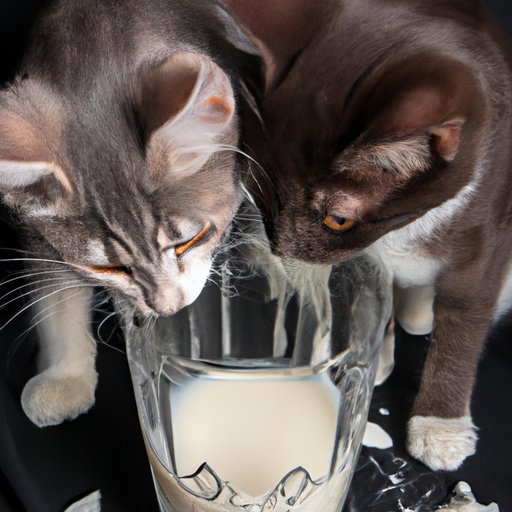
Introduction
As cat owners, we often want to spoil our furry friends with treats and indulgences, but when it comes to offering them milk, things can get confusing. There is a common belief that cats love milk, but is this really true? In this article, we will explore the truth behind giving cats milk and provide alternative treats that your feline friend can safely enjoy.
The Truth About Cats and Milk: Can They Safely Drink It?
Contrary to popular belief, cats should not be given milk. This common misconception has been perpetuated by images of cats lapping up milk in cartoons, movies, and even commercials. However, the reality is that cats are lactose intolerant, meaning that their digestive system cannot properly process lactose, the sugar found in milk.
When cats consume milk, they may experience digestive issues such as vomiting, diarrhea, and abdominal pain. These symptoms can be uncomfortable for your cat and can even lead to dehydration. Therefore, it is essential to understand that milk can be harmful to your cat’s health.
According to Lynn Buzhardt, DVM, cats “lack the necessary enzyme to break down lactose, the sugar found in milk. Drinking cow’s milk can upset a cat’s stomach and cause diarrhea and vomiting. Cheese and other dairy products should be avoided as well.”
Alternative Treats for Your Feline Friend: Milk-Free Options to Spoil Your Cat
Just because cats cannot safely drink milk does not mean that we cannot spoil them with other treats. There are various milk-free options that cats can safely enjoy, including:
- Catnip
- Wheatgrass
- Cooked meat, like chicken or turkey
- Canned pumpkin
- Fruits like melon and bananas (in moderation)
It is essential to note that treats should be given in moderation to maintain a healthy weight and digestive system. A highly recommended option for treats is the use of healthy homemade recipes which are packed with nutrients and do not have lactose. Below are some milk-free homemade cat treats recipes:
- Salmon and Oat Treats
- Pumpkin Spice Cat Treats
- Meow Chow Cat Treats
- Chicken and Parsley Cat Treats
- Banana and Peanut Butter Cat Treats
What Happens if You Give Your Cat Milk? The Dangers of Lactose Intolerance in Cats
If you give your cat milk or dairy-based products, it could lead to significant health problems. Symptoms of lactose intolerance in cats include:
- Vomiting
- Diarrhea
- Abdominal pain
- Dehydration
- Problems with digestion
Moreover, there is a risk of malnutrition if your cat becomes intolerant to lactose but continues to consume milk and dairy products. This risk is more significant in kittens, as milk is the primary source of nutrition for them.
According to Dr. Kerri Marshall, DVM, “the danger of giving milk outweighs its potential benefit.” She adds that “a little milk now and then has probably not killed any cat, but it’s better off not given.”
A Brief History of Cats and Milk: Why It’s a Common Misbelief That Cats Love Milk
The notion that cats love milk has been around for centuries. Herbivores like cows are a natural source for cats and other animals to find milk, which they drink during their early years of life. Kittens feed on their mother’s milk in the early stages of their life, and after they grow, their bodies stop producing lactase enzymes that break down lactose in milk. Dairy products like cheese and yogurt have up to 10 times the lactose content than that in the milk. As animals grow up, it’s ideal to turn to water and other liquids instead of dairy products.
Is Your Cat Begging for Milk? Here’s What You Need to Know Before You Pour
If your cat is begging for milk, you should pay attention to its body language and general behavior to know what to do. It may also be a sign that your cat is hungry or thirsty, so ensure you provide it with clean water and a healthy meal during feeding times. If you must give it treats and thinking of some new recipes, you should try out the recipes that are safe for consumption.
If you’re not sure whether your cat is lactose intolerant, it may be best to consult with your veterinarian. They can recommend the best options and help you develop a diet plan for your cat that fits its needs.
Conclusion
In conclusion, it’s apparent that while cats may enjoy having milk, it’s best to avoid giving it to them. Since cats are lactose intolerant, giving them milk, milk-based products, or even dairy-based products puts their health at risk. However, there are alternative treats that cats can safely enjoy without experiencing digestive problems. It is necessary to pay attention to what our cats eat to prevent future health risks and diseases.
By following the tips and recommendations outlined in this article, you can keep your cat safe, healthy, and happy. Remember, treat your feline friend with love and care, knowing well what they can handle and what they can’t. The type of treats you give them should be what benefits their health and well-being.





